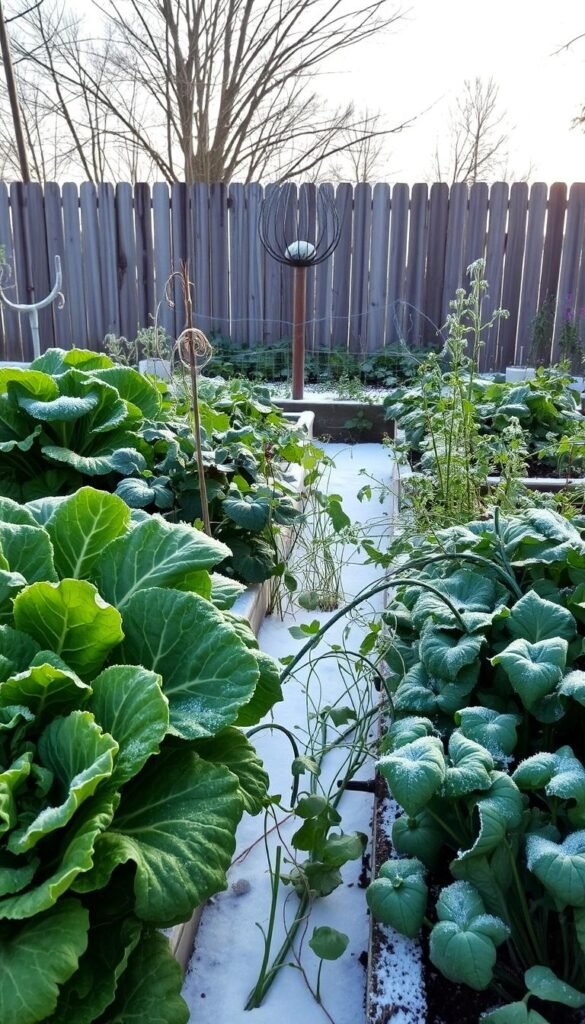Imagine growing food year after year without replanting. Plants like asparagus and rhubarb thrive through cold months, offering fresh harvests even as temperatures drop. These hardy crops save time and energy while building healthier soil ecosystems.
No-till methods work perfectly with these resilient plants. By avoiding soil disruption, you protect beneficial microbes and earthworms that boost nutrient availability. This approach also reduces erosion, keeping your plot productive through harsh weather.
Cold-tolerant varieties establish deep root systems that access water and minerals annuals can’t reach. Artichokes, for example, develop thick taproots that store energy for spring regrowth. You’ll spend less time prepping beds each season while enjoying consistent yields.
Winter gardening becomes simpler when plants naturally adapt to cooler conditions. Your role shifts from constant planting to strategic maintenance—mulching before frosts or pruning dormant stems. This sustainable system creates food security while letting nature handle heavy lifting.
Ready to transform how you grow food? Discover how combining permanent crops with gentle soil care unlocks a low-effort, high-reward growing strategy. Let’s explore practices that keep your plot vibrant even under snow.
Understanding Perennial Vegetables and Their Benefits
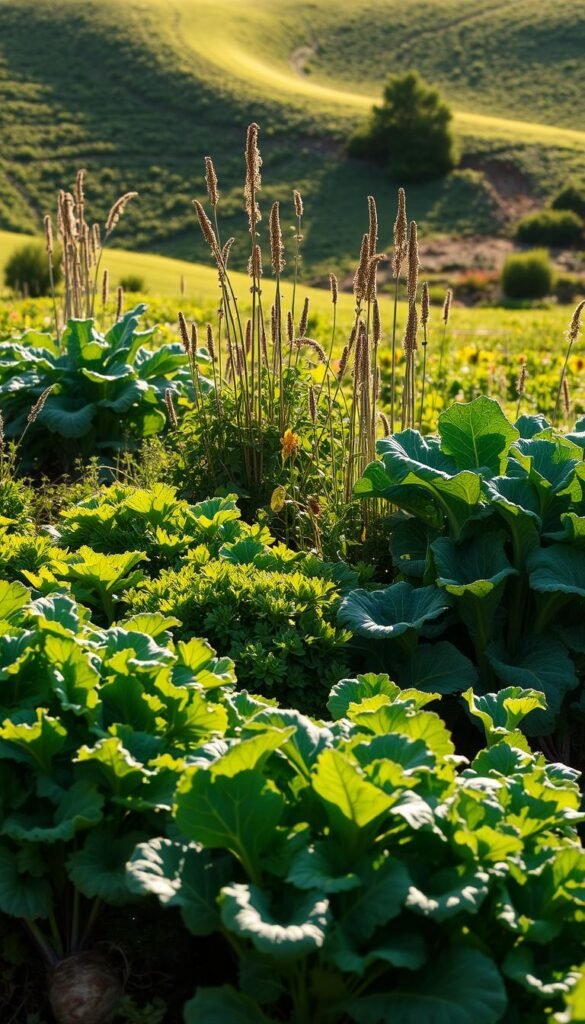
Think about harvesting fresh produce year-round with minimal effort. Unlike annuals that need replanting, these long-lived crops build resilience over time. Their secret lies underground—deep roots tap into hidden resources while protecting your garden’s foundation.
Year-Round Rewards With Less Work
You’ll save time since these plants return each season. Once established, they focus energy on growth rather than sprouting from seeds. Their extensive root systems access water deep in the soil, reducing irrigation needs during dry spells.
Many varieties offer staggered harvests. You might pick leafy greens in spring and edible shoots in winter. This constant production fills gaps when other gardens lie empty.
Nature’s Sustainable Partners
Undisturbed soil fosters thriving microbial communities. Earthworms and fungi create natural pathways for nutrients. No digging means carbon stays locked underground, fighting climate change quietly.
Thick roots prevent erosion during heavy rains or snowmelt. They also break up compacted earth over time, improving drainage without tools. You’ll use fewer fertilizers as plants recycle nutrients through fallen leaves and stems.
Exploring the No Till Approach for Winter Gardens
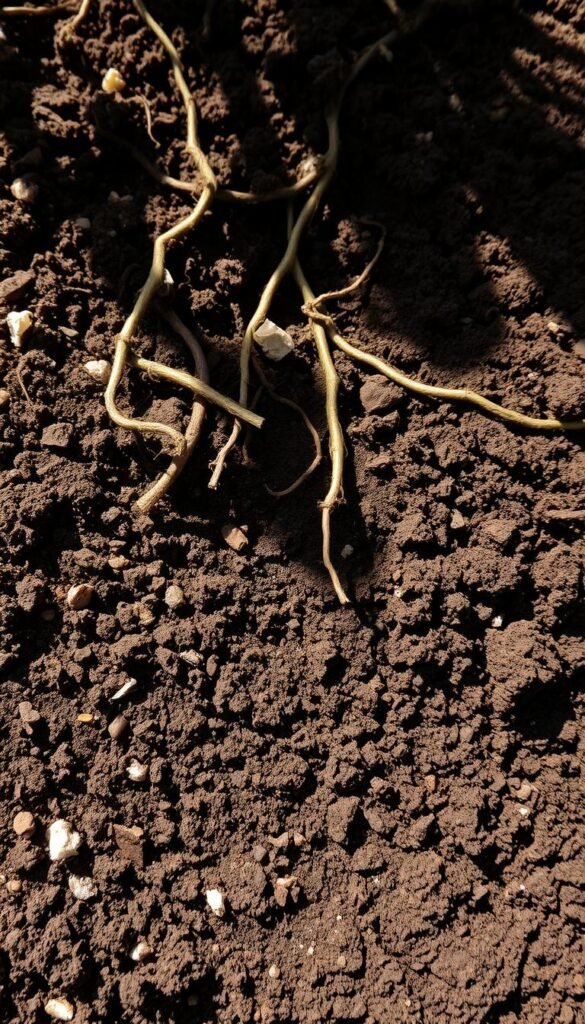
Healthy soil acts as a living ecosystem beneath your feet. When left undisturbed, it becomes a powerhouse supporting plant growth through freezing temperatures and thawing cycles. This natural resilience proves especially valuable when growing cold-hardy crops.
Preserving Soil Structure and Microbial Health
Tilling disrupts earth’s hidden helpers – bacteria and fungi that break down organic matter. These microorganisms form partnerships with plant roots, exchanging nutrients for sugars. Winter gardens thrive when these relationships stay intact.
Mechanical digging breaks apart soil aggregates, those tiny clumps that create space for air and water. Without them, heavy rains turn your garden into a muddy mess. Unbroken ground maintains drainage pathways while storing moisture for drier spells.
Fungal networks suffer most from shovel blades. These thread-like hyphae transport minerals across your plot, helping plants access nutrients locked deep underground. Undisturbed soil keeps this natural internet buzzing, even under snow cover.
You’ll notice fewer crusted surfaces in spring compared to tilled plots. Stable soil layers resist erosion from icy winds and melting snow. Organic matter decomposes slowly, feeding your crops instead of escaping as carbon dioxide.
Biological activity never fully stops in protected earth. Worms continue processing fallen leaves, while microbes prep nutrients for spring’s first sprouts. This quiet teamwork means healthier plants when growing seasons shift.
Preparing Your Winter Garden Beds Without Tilling
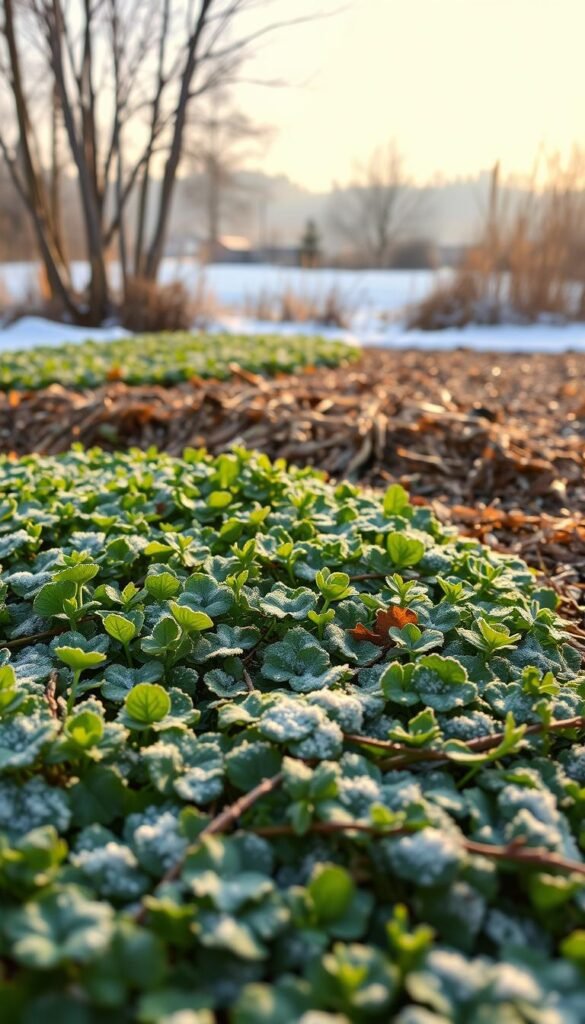
Transform your garden beds into winter-ready spaces using methods that keep soil intact. Start by trimming spent plants at ground level instead of yanking them out. Those leftover roots break down slowly, feeding earthworms and improving soil texture naturally.
Using Mulch and Cover Crops for Protection
Blanket your beds with organic materials before frost arrives. Straw or shredded leaves create insulation against temperature swings. This layer prevents weeds while letting moisture seep through to plant roots.
Plant cold-hardy cover crops like winter rye in early fall. Their dense growth shields soil from erosion while adding nitrogen as they decompose. Field peas work well in milder climates, forming living mulch that enriches beds.
Remove diseased foliage completely but leave healthy stems standing. Air circulation matters—avoid piling mulch too thickly around plant bases. Aim for 3-4 inches of coverage to balance protection and breathability.
Time your prep work after the first light frost but before ground freezes. This schedule lets soil organisms process organic matter gradually. Come spring, you’ll find crumbly, nutrient-rich earth ready for planting.
Optimizing Soil Health for Cold-Weather Growth
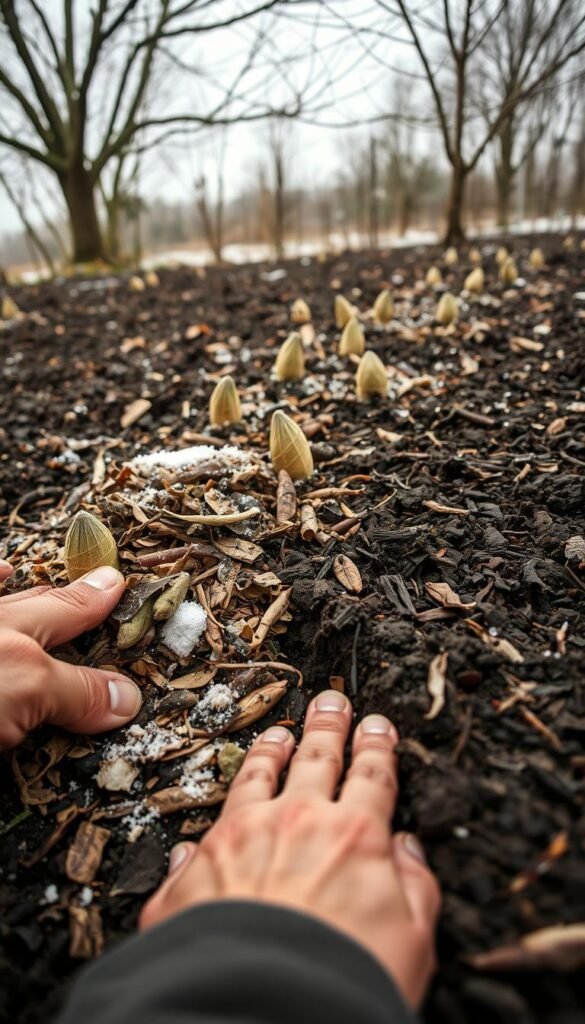
Want your winter garden to thrive even as temperatures drop? The secret lies in feeding your soil like a living pantry rather than a static growing medium. Cold-hardy plants need nutrient-rich earth that retains warmth and supports microbial activity through freezing months.
Integrating Organic Amendments and Compost
Fall is prime time to top-dress beds with finished compost. This slow-release buffet feeds soil organisms all winter, releasing nutrients just as plants wake up in early spring. Test your soil every 2-3 years to identify missing minerals—kelp meal adds trace elements, while rock dust replenishes calcium and magnesium.
Use a broadfork in spring to gently mix amendments into the top 4 inches. This aerates compacted areas without destroying worm tunnels or fungal networks. Aged manure works wonders here—apply it 6 weeks before planting to let nutrients mellow.
For year-round benefits, layer compost as mulch after fall harvests. Earthworms will gradually incorporate it, building organic matter that insulates roots and retains moisture. Your soil becomes richer each season, creating ideal conditions for cold-tolerant vegetables to establish deep, resilient root systems.
Balance is key—too much nitrogen can delay dormancy. Focus on balanced amendments that support steady growth without overwhelming plants. With this approach, you’ll spend less time fixing problems and more time enjoying robust winter harvests.
Key No Till Techniques for a Healthy Garden
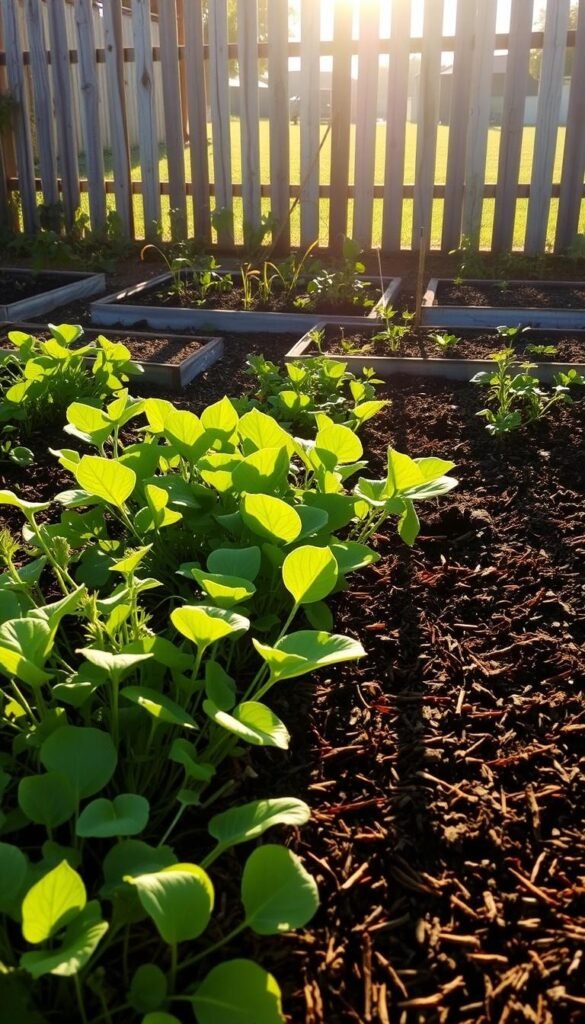
Ready to unlock your garden’s full potential? Start by keeping soil covered year-round. Living plants, mulch, or breathable tarps protect earth from erosion while feeding beneficial organisms. This simple practice shows how nature thrives when given consistent shelter.
Strategic covers work wonders. Try landscape fabric in early spring to warm soil without tilling. Pre-cut garden mats with planting holes let you grow crops while blocking weeds. For winter protection, tarps prevent nutrient loss from heavy rains or snowmelt.
Weed control becomes easier when you focus on prevention. A 3-inch mulch layer stops most unwanted sprouts. If invaders appear, slice them at ground level with a stirrup hoe. This tool removes weeds without disturbing soil structure or microbial networks.
Smart pathway planning reduces compaction. Use stepping stones or wood chips in walking areas to protect planting zones. These routes let you tend plants all season while maintaining loose, airy soil where roots grow deepest.
Water management improves naturally with proper coverage. Mulched beds retain moisture better than bare earth, while cover crops guide rainfall into the ground. Pair these methods with a productive vegetable garden layout for maximum efficiency.
Nourish beds by top-dressing compost around established plants. This feeds soil life without digging, preserving delicate root systems. Over time, these techniques create self-sustaining ecosystems that require less work each season.
Caring for Perennial Vegetables in a No Till Winter Garden
What keeps these hardy crops thriving through freezing months? It starts with understanding their unique needs. Asparagus crowns demand thick straw blankets, while rhubarb benefits from leaf mold piled around its base. Timing matters—apply mulch after the first hard frost to let plants enter dormancy naturally.
Moisture management becomes crucial when growth slows. You’ll want to check soil dampness monthly, especially during dry spells. A simple finger test works: if the top 2 inches feel parched, water sparingly at midday when temperatures rise slightly.
Spotting stress signs early prevents bigger issues. Look for cracked bark on sunchokes or discolored sorrel leaves—these signal dehydration or nutrient deficiencies. Address problems by top-dressing compost instead of digging, preserving underground ecosystems.
Prune strategically to maintain plant health without disturbing roots. Remove dead artichoke stalks but leave 6-inch stubs to trap insulating snow. For bunching onions, trim yellowed tips while keeping green foliage intact for photosynthesis.
“Layering different mulches creates microclimates,” notes Vermont gardener Elise Tran. “I use evergreen boughs over shredded bark for wind protection.” This approach shields plants while feeding earthworms as materials break down.
Your efforts pay off come spring. Well-tended crops rebound faster, their root systems primed for new growth. With each season, you’ll refine techniques that honor both plant resilience and soil vitality.
Planting Techniques and Seasonal Timing
Timing your plantings perfectly unlocks nature’s growth cycles. Cooler months offer unique advantages for establishing robust root systems while minimizing stress on both plants and soil.
Working With Nature’s Calendar
Artichokes thrive when planted from October to December using rootstock divisions. Space them 3-4 feet apart to accommodate their sprawling silver-green foliage. In mild regions like California’s Bay Area, winter becomes prime time for settling these Mediterranean natives into their permanent homes.
For asparagus crowns, target January through March planting in trenches. This timing lets roots establish before spring’s growth surge. “Dormant-season planting reduces transplant shock by 40%,” notes University of California research. Cool soil temperatures help plants focus energy below ground.
Summer planting often backfires—heat stresses young perennials when they should be conserving resources. Instead, use fall and winter months to position plants where they’ll grow for years. Check soil drainage first by digging a test hole; water should drain within 2 hours.
Proper spacing proves crucial. Overcrowded plants compete for nutrients and harbor diseases. Map mature sizes before placing each specimen—allow walking paths between artichoke patches and asparagus rows. This foresight pays off during harvest seasons.
Maintenance Tips for Long-Lasting Vegetable Beds
How do you keep edible plants thriving for decades? The answer lies in smart care routines that protect both crops and soil. Thoughtful pruning and growth management become your secret weapons for beds that improve with age.
Pruning and Managing Plant Growth
Cut artichoke stalks at ground level after harvest using angled cuts. This prevents water pooling and disease. For asparagus, resist harvesting spears during the first two seasons. “Patience pays off—third-year yields often triple,” notes Oregon grower Elise Tran.
Remove bunching onion flower stalks before they bloom. This redirects energy to bulb multiplication instead of seed production. Always use clean tools to avoid spreading pathogens between plants.
Refresh mulch layers annually in early spring. Add compost around established roots without digging—earthworms will mix nutrients naturally. Check beds monthly for discolored leaves or stunted growth, which signal nutrient needs.
Rotate harvest areas to prevent overworking plants. Take only 30% of leafy greens at once, allowing quick recovery. This approach maintains soil balance while keeping your kitchen stocked for years.
Time interventions carefully. Prune during dry weather to minimize infection risks. Leave healthy stems standing through winter—they trap snow for insulation and provide habitat for beneficial insects.
Irrigation Strategies and Water Conservation
Watering wisely during colder months can make or break your garden’s success. Plants need different care when temperatures drop—too much moisture invites rot, while too little stresses roots. Learn to read your soil’s signals and adapt to seasonal shifts.
Smart Moisture Management
Drip systems outperform sprinklers in winter by delivering water directly to roots. Pair them with timers set for midday when ice risk drops. Early watering lets soil absorb moisture before nighttime freezes.
Check dampness monthly using the finger test—dry topsoil doesn’t always mean thirsty plants. Probe deeper: if 3 inches down feels cool, hold off. Artichokes need zero summer irrigation but require weekly drinks during active growth seasons.
Mulch acts like a sponge, slowing evaporation while insulating roots. Refresh layers after heavy rains to maintain 2-3 inch coverage. For asparagus beds, water every 10 days unless snowpack exists.
Extend your growing calendar using greenhouse strategies that balance humidity and airflow. These tips help conserve resources while keeping plants vigorous through temperature swings.

